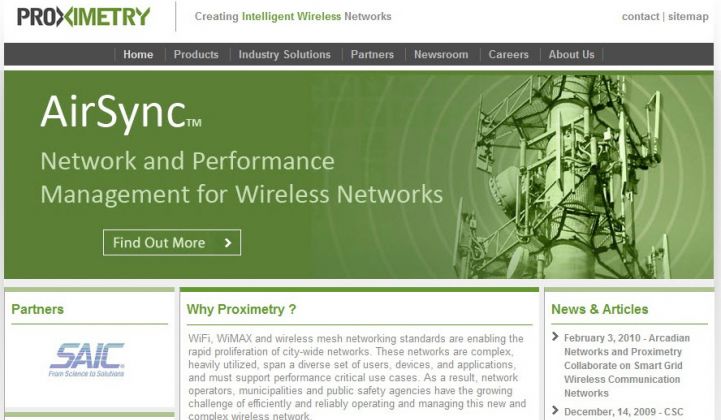Proximetry, the startup that says it can intertwine millions of utility devices and multiple communications networks into a unified, better-functioning whole, just got a big new partner to roll out its vision to utilities.
Siemens announced Wednesday that it’s integrating Proximetry’s Airsync Network Management System into North American electric, gas and water grid projects, via its PM@Siemens project management business. The goal, according to the joint press release, is a smart grid platform that can “manage multiple networks, protocols, and millions of devices seamlessly from a single control center.”
The companies didn’t disclose financial details of the arrangement, or where they might be working together. But there’s no doubt that this is a big win for San Diego-based Proximetry, which was founded in 2005 and has raised an estimated $6 million from investors, including Munich Venture Partners, Aeris Capital, Investec, and Rembrandt Venture Partners, including a $5 million Series A round in 2007 and $792,000 of a planned $1.08 million round in 2011.
Proximetry has already been working with some 200 deployed customers with partners that include SAIC, CA, Boeing, RuggedCom, CSC Corp. and, of course, big smart grid networking player Cisco. On Monday, Proximetry announced another partnership with 4G wireless technology provider Airspan.
But Siemens, one of the “four horsemen” of the grid alongside GE, ABB and Schneider Electric (add Alstom to make it five), could open up a huge new market. Siemens will essentially be reselling Proximetry’s technology bundled in its various smart grid efforts, CEO Tracy Trent told me in an interview.
“I think this potentially is a very big partnership for us -- and even more, someone embracing a broader vision of what we think AirSync is capable of,” he said.
Andres Carvallo, Proximetry’s CTO and a notable in the smart grid field, explained that today’s utility environment consists of a lot of proprietary, siloed networks, using a host of legacy SCADA, radio or even telephone line communications. Even the most modern smart grid communications, which may be standards-based and built to more easily integrate with today’s back-end IT systems, are typically built by single vendors to run on their own equipment, he said.
In simple terms, Carvallo explained, Proximetry uses a client-server approach to the grid networking problem. First, it embeds its intelligence into each end device on a utility’s network -- a figure that can add up to tens of millions for big utilities -- then connects them all to a central server at the utility control center or to the cloud, he said.
That establishes a resilient, two-way connection to each device, he said -- something that other network management systems may not do. While every smart grid networking vendor has their own version of an NMS for their own gear, they don’t have the same functionality for other vendors’ gear, he noted. That’s led GTM Research senior smart grid analyst Emma Ritch to label such single-vendor solutions “element management systems,” to differentiate them from the pan-vendor capabilities of a “true” NMS.
Carvallo added that other systems that seek to manage multiple networks have tended to be more monitors than managers, so to speak: they spot problems, but don’t necessarily take on the responsibility of correcting them.
Proximetry, on the other hand, “enables closed-loop control at the device…and policy-based management on the control side,” he said. “We’re making them all function as one.”
Proximetry isn’t alone in trying to bring network management solutions to the smart grid. Cisco has built its own NMS capabilities into its broader smart grid architecture, though it’s also working with Proximetry on some of its utility deployments of the technology. SK Telecom’s U.S. subsidiary GridMaven is also tackling smart grid NMS, targeting U.S. markets but with projects including South Korea’s Jeju Island smart grid test bed. Telcordia, now owned by Ericsson, has a smart grid NMS offering.
As for Siemens, it just launched a new smart grid architecture push at this week’s DistribuTECH show, including a new line of protection gear, and its Spectrum Power 7 platform, which essentially integrates generation and transmission grid management platforms, distribution management systems and energy market interfaces via enterprise service-oriented architecture. In other words, it ties three traditionally siloed utility IT infrastructures into a more modern, integrated system.
Siemens also bought Silicon Valley meter data management software vendor eMeter in late 2011, and Thierry Godart, president of Siemens’ North American smart grid division, said in a Tuesday interview that eMeter’s EnergyIP platform is serving as a core part of its new Spectrum smart grid integration offering. But other pieces of the smart grid architecture graph Siemens shared with the media on Tuesday -- such as the all-important layer that connects distributed devices into a network to tie into back-end systems -- were left blank in terms of what partners Siemens might be working with, if any.
While Siemens doesn’t make smart meters itself, it does make a great share of the world’s grid equipment, as well as the SCADA networks that monitor and control that equipment -- and over the past few years, Proximetry has expanded from its previous focus on managing wireless networks to include such wired systems as SCADA.
GTM’s Emma Ritch noted that the Proximetry-Siemens partnership “validates the value of networking solutions. The industry is moving toward an environment in which the type of communications matters less than the overall network infrastructure,” she said. “Proximetry's solution helps enable holistic views and control of networks, regardless of the medium.”



